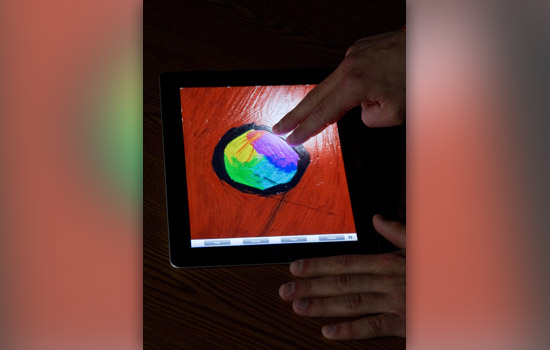Paint on an iPad with tangiPaint...
Application builds on researchers’ Tangible Display Technology
Anthony Blatner
The tangiPaint digital application allows visitors to paint on an iPad using their fingers instead of brushes. They can change the paint application, the surface orientation and the lighting of a digital composition.
Visitors to the tangiPaint: A Tangible Digital Art System exhibit in the Gordon Field House and Activities Center will have an opportunity to paint on an iPad.
TangiPaint (tangible + paint) is a digital painting application that approximates the experience of applying oil paints to a canvas.
“The tablet-based digital painting system attempts to bridge the gap between the real and digital worlds,” says Jim Ferwerda, associate professor in the Munsell Color Science Laboratory in the Chester F. Carlson Center for Imaging Science. “It allows artists to work with digital media that look and behave like real materials.”
Visitors will manipulate a digital canvas with simple fingerstrokes on a multitouch display screen. TangiPaint is an application developed by graduate student Anthony Blatner, assistant professor Reynold Bailey, Ferwerda and graduate student Ben Darling that leverages the Tangible Display technology he and Darling introduced last year at Imagine RIT. The display technology taps the capabilities of the iPad’s accelerometer and graphics hardware to change the orientation of a painting and its appearance under different light sources.
“Digital paints are two dimensional,” Ferwerda says. “You can change the color and some have texture, but they don’t have surface reflectance or impasto. TangiPaint lets you lay down brush strokes that are thick or that have gloss or texture to them, and you can see that as you move it around.”
TangiPaint approximates the three-dimensional layering or the flow of the oil paint on the canvas. It captures the matt or gloss properties and the relief that provide depth. Visitors can tilt an iPad to simulate light reflecting off a digital canvas and modify scene lighting with a two-fingered stroke to the multitouch screen.
“The tangiPaint system represents a first step toward developing digital art media that look and behave like real materials,” Ferwerda says.











